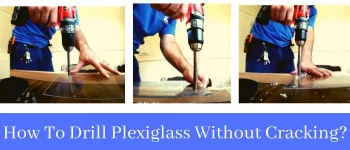Plexiglass, or acrylic glass, is a clear plastic with outstanding strength and clarity. It is often used in place of regular glass in applications where safety is a concern, since it will not shatter if broken. Plexiglass can be cut and drilled using standard woodworking tools, but extra care must be taken to avoid cracking or shattering the material.
Plexiglass is a type of thermoplastic, meaning it will soften and distort when heated. When drilling plexiglass, it is important to use sharp drill bits and go slowly to avoid cracking the material
- Begin by marking the center of where you want to drill with a permanent marker
- Next, using a small bit, make a pilot hole in the plexiglass to prevent the larger bit from slipping
- Slowly drill into the plexiglass with a larger bit, applying even pressure while going slowly.
What is the Best Way to Drill Holes in Plexiglass?
Plexiglass is a type of acrylic plastic with a similar appearance to glass. It is often used as an alternative to glass because it is shatter-resistant and has a lower weight. Plexiglass can be cut and drilled like other types of plastic, but there are a few things to keep in mind to avoid damaging the material.
To drill a hole in plexiglass, start by using a sharpened bit designed for drilling plastics. A dull bit will cause the material to melt and chip. It’s also important to use low speeds and moderate pressure when drilling.
If the plexiglass starts to crack or chip, stop immediately and try another method.
One way to avoid cracking or chipping the plexiglass is to use a step drill bit. This type of bit has multiple cutting edges that create small pilot holes as it drills through the material.
Step drill bits are available in sizes up to 1/2 inch (1.3 cm), so they can be used for larger projects as well.
Another option is to score the plexiglass first with a utility knife before drilling into it. This will help prevent cracking by giving the drill bit something else to grip onto as it starts its hole.
First, make a series of shallow cuts along your desired line with the utility knife. Then, set your drill bit at slow speed and medium pressure, and carefully start drilling into the scored line until you’ve created your hole..
How Do You Drill Big Holes in Acrylic Without Cracking?
Acrylic is a strong and durable material, but it can be tricky to drill holes in without cracking. Here are a few tips to help you get the job done:
-Choose the right drill bit.
A standard twist bit will not work on acrylic; instead, opt for a carbide-tipped or diamond-tipped bit.
-Use a slower speed. When drilling, go slowly at first to avoid cracking or shattering the material.
-Apply pressure evenly. Put pressure on the drill bit evenly as you’re drilling; too much pressure in one spot can cause the acrylic to crack.
-Use a coolant.
Acrylic tends to heat up quickly when being drilled, so using a coolant (like water) can help keep it from getting too hot and cracking.
Best Drill Bit for Plexiglass
When it comes to Plexiglass, you will want to use a drill bit that is made specifically for plastics. This is because regular metal drill bits can cause the Plexiglass to crack or shatter.
There are two main types of drill bits that can be used on Plexiglass: carbide-tipped and diamond-tipped.
Carbide-tipped drill bits are made from a harder material than regular metal drill bits, so they will stay sharp longer and produce less heat while drilling.
The best type of drill bit to use when drilling plexiglass is a carbide-tipped drill bit. These bits are designed to cut through hard materials without chipping or breaking them. When shopping for a carbide-tipped drill bit, look for one that has a point angle of 135 degrees.
This will help to prevent the bit from walking on the surface of the plexiglass as you start to drill.
Diamond-tipped drill bits are even more durable than carbide-tipped bits and will also create less heat while drilling, making them ideal for use on Plexiglass.
Another thing to keep in mind when drilling plexiglass is to go slowly and use plenty of lubrication. A water-based lubricant such as WD-40 will help to keep the drill bit cool and prevent it from overheating and damaging the plexiglass.
Start by drilling a small pilot hole before increasing the size of the hole with successive drills.
Conclusion
Plexiglass, also known as acrylic glass, is a clear plastic material with great strength and durability. It is often used in place of regular glass because it is shatter-resistant and can be easily cut to size. When drilling plexiglass, it is important to use the correct type of drill bit and to go slowly to avoid cracking the material.
